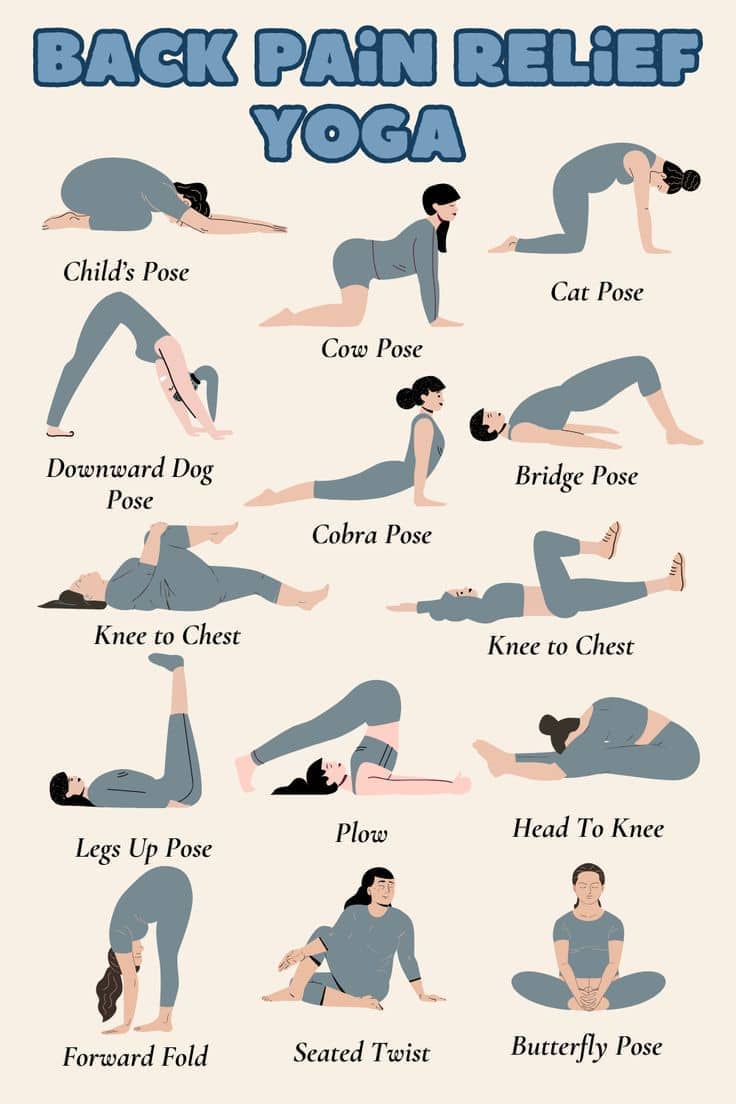Yoga for Back Pain Relief: Your Comprehensive Guide to Soothing and Strengthening the Spine
Back pain is one of the most common health concerns worldwide, affecting millions of people every day. Whether you’re a desk worker, a busy parent, or an active athlete, persistent discomfort in your lower back, mid-back, or upper back can severely impact your quality of life. Fortunately, yoga offers an accessible, holistic approach to managing and relieving back pain. By combining gentle stretches with mindful breathing and improved body awareness, yoga can help alleviate back tension, reduce stiffness, and support a healthy, strong spine.
In this comprehensive guide, we will explore several time-tested yoga poses that can help soothe back pain and promote better spinal health. The sequence we’ll discuss is safe for most individuals—but as always, it’s crucial to listen to your body and consult with a healthcare professional before starting any new exercise regimen.
Table of Contents
- Why Yoga Helps With Back Pain
- Safety Precautions and Tips
- Essential Yoga Poses for Back Pain Relief
- Tips for Practicing Yoga Safely at Home
- Frequently Asked Questions
- Conclusion
Why Yoga Helps With Back Pain
The principles of yoga revolve around the union of body, mind, and breath. This synergy enhances physical alignment, muscle balance, flexibility, and mental clarity. Here’s why yoga is so effective for back pain:
- Strengthening Core and Back Muscles: Many yoga poses help stabilize the spine by activating the core muscles—your abdominals, obliques, and lower back extensors. Strength in these areas offers a supportive girdle for the spine, preventing excessive strain on the vertebrae and discs.
- Improving Posture: Poor posture, whether from desk work or simply not standing upright, can exacerbate back pain. Yoga emphasizes correct spinal alignment through mindful movement, encouraging you to stand, sit, and move in a healthier way throughout your day.
- Enhancing Flexibility: Tight muscles—particularly in the hamstrings, hips, and shoulders—often contribute to back pain. Yoga stretches these areas gently, increasing overall flexibility and releasing tension that pulls on the spine.
- Promoting Relaxation and Stress Relief: Stress can manifest physically, leading to muscle tightness, especially around the neck, shoulders, and lower back. Mindful breathing and relaxation in yoga help alleviate this tension, improving circulation and providing relief.
- Preventing Future Injuries: By cultivating body awareness and balanced muscle engagement, yoga can reduce the risk of re-injury or chronic pain flare-ups.
Safety Precautions and Tips
While yoga is generally safe, especially if you approach it gently, it’s vital to take the following precautions for a secure, beneficial practice:
- Consult a Professional: If you have chronic or severe back pain, consult with a healthcare provider or physical therapist before attempting any new poses.
- Warm Up Properly: Spend a few minutes doing gentle stretches or taking a brisk walk to warm up muscles before you start your yoga routine.
- Use Props When Needed: Yoga blocks, blankets, bolsters, and straps can help you modify poses, reducing strain on tight areas.
- Maintain Steady Breathing: Avoid holding your breath during poses. Breathing deeply and consistently calms the nervous system and helps muscles relax more effectively.
- Avoid Overstretching: Listen to your body’s limits. If you feel pain (beyond mild discomfort), back out of the pose to a more comfortable range or skip it entirely.
- Practice Consistently: Regular, gentle practice promotes better results than doing an intense practice sporadically.
Essential Yoga Poses for Back Pain Relief
Below are some poses famously known to help reduce tension, build stability, and support your spine’s natural curvature. Each pose description includes step-by-step instructions, key benefits, and tips for optimal alignment.
1. Child’s Pose
How to Do It:
- Kneel on the floor, bringing your knees either together or slightly apart.
- Sit your hips back onto your heels.
- Extend your arms forward on the floor, lowering your forehead down.
- Breathe deeply, feeling your lower back elongate.
Benefits:
- Gently stretches the spine, hips, thighs, and ankles.
- Encourages relaxation and reduces stress, which helps ease tension in the back muscles.
Tips:
- If your forehead doesn’t comfortably reach the floor, place a block or folded blanket beneath it.
- Focus on feeling a gentle tug through the lower back—nothing should hurt or pinch.
2. Cat Pose
How to Do It:
- Start on all fours (hands and knees) with your wrists aligned under your shoulders and knees under your hips.
- On an exhale, round your spine upward, tucking your chin toward your chest and drawing your belly button toward your spine.
- Keep pressing through your hands for an even stretch across the entire back.
Benefits:
- Increases mobility in the spine by encouraging an articulated rounding.
- Releases tightness in the upper back and neck.
Tips:
- Move slowly, ensuring you’re not forcing the rounding of the spine.
- Coordinate each movement with the breath for maximum effect.
3. Cow Pose
How to Do It:
- From the same starting position on all fours, inhale as you arch your back in the opposite direction of Cat Pose.
- Lift your chest forward, and gently tilt your tailbone upward.
- Let your belly drop toward the ground, but keep your core lightly engaged to protect the lower back.
Benefits:
- Strengthens the lower back by creating a gentle arch.
- Improves spine flexibility and stretches the torso, chest, and neck.
Tips:
- Lift your gaze slightly if it’s comfortable, but avoid crunching the back of your neck.
- Focus on creating length from tailbone to crown of the head.
4. Downward Dog Pose
How to Do It:
- Begin on all fours, then lift your knees off the floor and straighten your legs (or keep them slightly bent if your hamstrings are tight).
- Push your hips up and back, forming an inverted “V” shape with your body.
- Press evenly into your palms and keep your neck relaxed, looking toward your thighs or belly button.
Benefits:
- Stretches the entire back body, including the hamstrings and calf muscles.
- Lengthens the spine, alleviating compression in the vertebrae.
Tips:
- If your lower back rounds excessively, bend your knees or shorten your stance.
- Spread your fingers wide to distribute weight evenly across your hands.
5. Cobra Pose
How to Do It:
- Lie on your stomach with your legs extended and tops of your feet flat on the floor.
- Place your palms under your shoulders, elbows close to the sides of your body.
- Inhale as you gently lift your chest, rolling your shoulders back.
- Keep your lower ribs on the floor for a low cobra, or lift higher if comfortable (but avoid straining the lower back).
Benefits:
- Strengthens the spine and the supporting muscles.
- Opens the chest and helps improve posture by counteracting forward rounding of the shoulders.
Tips:
- Engage your abdominal muscles slightly to support your lower back.
- Keep your shoulders relaxed and away from your ears.
6. Bridge Pose
How to Do It:
- Lie on your back with your knees bent and feet hip-width apart, close to your buttocks.
- Press your feet into the floor and lift your hips up.
- Interlace your fingers under your back and shuffle your shoulders underneath you if possible.
Benefits:
- Strengthens the glutes and lower back muscles, providing stability to the spine.
- Stretches the chest, shoulders, and neck area.
Tips:
- Keep your knees aligned directly over your heels.
- Try not to let the knees splay outward or inward excessively.
7. Knee-to-Chest Pose
(Note: This pose is sometimes done as single-leg knee-to-chest or with both legs at once.)
How to Do It (Single-Leg):
- Lie on your back with your legs extended.
- On an exhale, draw one knee toward your chest, holding it gently with your hands.
- Press your lower back into the floor as you feel a stretch in your glutes and lower back.
Benefits:
- Releases tension in the lumbar spine.
- Stretches the hips and glutes, key areas often contributing to lower back pain.
Tips:
- If you experience any discomfort in the knee or hip, adjust the angle or reduce the intensity of the pull.
- For double-leg knee-to-chest, bring both knees in at the same time, but be mindful of not over-rounding the lower back.
8. Legs Up Pose
How to Do It:
- Sit with one side of your body against a wall.
- Swing your legs up onto the wall as you lie down on your back, buttocks close to the wall.
- Allow your arms to rest at your sides, palms facing up, or place them on your belly.
Benefits:
- Improves circulation and reduces tension in the lower back by giving the spine a mild decompression.
- Helps with relaxation and can ease swelling in the legs.
Tips:
- If hamstrings are tight, you can move slightly away from the wall.
- Use a folded blanket under your lower back or head for extra support and comfort.
9. Plow Pose
How to Do It:
- Lie on your back with your legs extended.
- Engage your core to lift your legs and hips off the floor, bringing your feet overhead.
- Aim to touch your toes to the ground behind your head, or rest them on a chair or block if the floor is unreachable.
Benefits:
- Stretches the spine, shoulders, and hamstrings deeply.
- Stimulates blood flow to the upper body and can help relieve tension in the lower back.
Tips:
- This pose can be intense: practice caution if you have neck or shoulder issues.
- You can keep your hands on your lower back for support if needed.
10. Head-to-Knee Pose
How to Do It:
- Sit on the floor with one leg extended forward, the other leg bent so the foot rests against the inner thigh of the extended leg.
- Inhale to lengthen the spine, then exhale as you fold forward over the extended leg.
- Keep your spine straight as you hinge from the hips.
Benefits:
- Stretches the hamstrings, which can alleviate pull on the lower back.
- Gently opens the lower back and promotes relaxation.
Tips:
- Use a strap around your foot if reaching your toes is challenging.
- Keep your chest open and spine long, avoiding excessive rounding.
11. Forward Fold
How to Do It:
- Stand with your feet hip-width apart, knees slightly bent.
- On an exhale, fold from the hips, bringing your torso over your legs.
- Let your head and neck relax, possibly bending your knees more if you have tight hamstrings.
Benefits:
- Relieves tension in the hamstrings and entire back, including the lumbar area.
- Encourages blood flow to the head and upper body for a revitalizing effect.
Tips:
- If your lower back feels strained, bend your knees generously or use a block to rest your hands on.
- Focus on relaxing the neck; avoid forcing yourself to reach the floor.
12. Seated Twist
How to Do It:
- Sit on the floor with your legs extended in front of you.
- Bend one knee and place the foot either on the floor outside the opposite thigh or keep it in a more comfortable position.
- Inhale, lengthen the spine, and exhale as you twist your torso toward the bent knee.
- Place your opposite arm on the outside of your bent knee to deepen the twist gently.
Benefits:
- Helps maintain spinal mobility and releases tension in the mid-back.
- Aids digestion and massages internal organs when done carefully.
Tips:
- Keep your spine long; avoid rounding your back as you twist.
- Twist from the base of your spine, moving upward gently.
13. Butterfly Pose
How to Do It:
- Sit upright and bring the soles of your feet together, letting your knees fall out to the sides.
- Clasp your hands around your feet or ankles.
- Keep your spine straight as you allow the knees to relax toward the floor.
Benefits:
- Opens the hips and groin region, helping alleviate tension that can radiate to the lower back.
- Encourages proper posture and circulation in the pelvis.
Tips:
- If your knees are high off the ground, place pillows or blocks under them for support.
- Avoid rounding your upper back; engage your core lightly.
Tips for Practicing Yoga Safely at Home
- Create a Dedicated Space: Choose a quiet, comfortable area with enough room to move freely. Use a yoga mat or a non-slip surface to prevent injuries.
- Set the Mood: Dim the lights, play soft music, or light a candle to foster relaxation.
- Listen to Your Body: If a pose causes pain, modify it or skip it. There’s no need to push through discomfort.
- Follow a Routine: Consistency yields better results. Start with short sessions—10 to 20 minutes—and gradually increase the duration as you build confidence and flexibility.
- Integrate Mindful Breathing: Proper breathing enhances the effectiveness of each stretch. Inhale to lengthen, exhale to deepen.
- Consider Online Classes: If you’re a beginner, guided instruction can help ensure proper alignment. Many reputable yoga instructors offer virtual classes or free tutorials on video platforms.
Frequently Asked Questions
1. Is yoga safe for herniated discs or severe back injuries?
It can be, but it’s crucial to get clearance from a healthcare professional. In some cases, certain poses need to be avoided or significantly modified. A physical therapist or a certified yoga therapist can guide you on safe modifications.
2. How often should I do these poses to see results?
For most people, practicing 3–5 times a week can yield noticeable improvements in flexibility, strength, and pain relief. However, even short daily sessions can be beneficial if done consistently and carefully.
3. Can I still benefit from these poses even if I’m not flexible?
Absolutely! Yoga is adaptable. If you can’t reach the floor or your feet in a pose, use props like blocks, straps, or pillows to bridge the gap. Over time, your flexibility and comfort level should improve.
4. Should I do a warm-up before jumping into these poses?
Yes. Simple warm-ups such as shoulder rolls, gentle side bends, or a brief walk can help loosen stiff joints and prepare the body for deeper stretches.
5. I have neck pain as well. Can I still practice these poses?
In many cases, yes. However, you may need to be extra mindful of neck positioning—especially in poses like Plow or Bridge. Always keep your neck in a neutral position unless instructed otherwise by a qualified professional.
Conclusion
Back pain can be both physically and mentally draining. Fortunately, yoga provides a natural, accessible means of relief by addressing the root causes: muscle imbalances, poor posture, stress, and a lack of body awareness. Whether you’re a complete beginner or a seasoned practitioner, the mindful stretches and poses outlined here can help soothe tense muscles, stabilize your spine, and promote overall well-being.
Remember, consistency is key. Practicing these yoga poses a few times per week—and pairing them with mindful breathing, proper hydration, and a balanced diet—can significantly reduce back pain and improve your quality of life. Always listen to your body’s signals, respect your limits, and consult with a healthcare professional for personalized guidance. By taking these steps, you’ll be well on your way to a healthier back, a calmer mind, and a more vibrant you.
Disclaimer: The information provided in this article is for educational purposes and does not replace professional medical advice. If you have chronic or severe back pain, or any pre-existing medical conditions, consult your doctor or a qualified healthcare provider before starting a new exercise program.
By integrating these gentle yoga poses into your routine, you can cultivate a powerful practice to relieve back pain and strengthen your spine. Embrace patience, maintain proper alignment, and be consistent—your body will thank you for the mindful care and attention!










